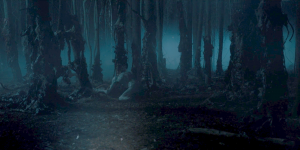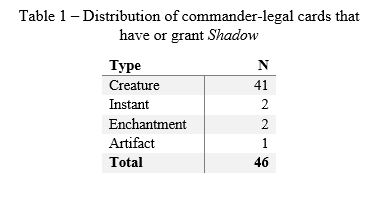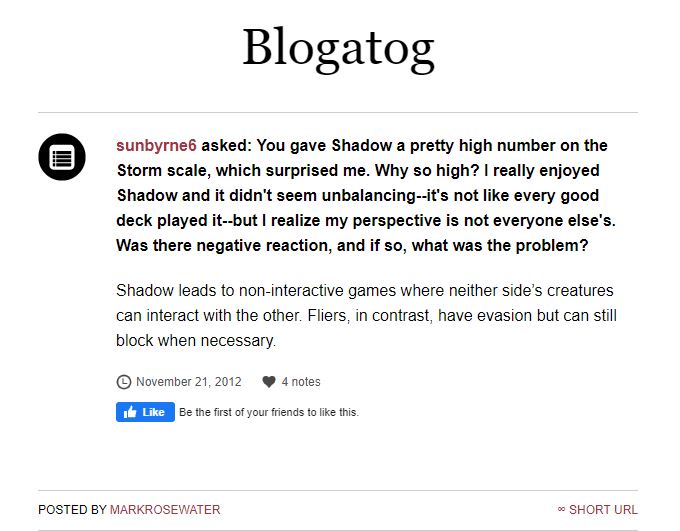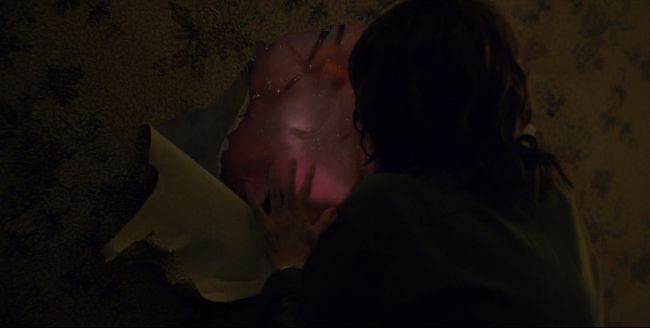(Shadow RiftShadow Rift | Art by Adam Rex)
Where the Sun Don't Shine
Greetings sleuths, saboteurs, skulkers! Welcome to another installment of Evasive Maneuvers, where we examine keywords and strategies that help get our creatures through during combat.
This week, we'll be travelling to Magic's equivalent of The Upside Down and taking a look at Shadow. Originally debuted in the Tempest block, Shadow states that a creature with Shadow cannot be blocked except by creatures with Shadow. However, unlike our previous peeks at the parasitic potential of flying, Flanking, and Horsemanship, Shadow comes with one additional restriction: creatures with Shadow can only block other creatures with Shadow.
From a flavor standpoint, Shadow is just straight unctuous umami goodness. Yawgmoth, Thran PhysicianYawgmoth, Thran Physician, in his infinite ambitions to invade and colonize other planes, merged his flowstone plane of Rath with Dominaria, creating an interstitial extraplanar void. Three Dominarian communities of Humanoid/Spirit-like beings, the Dauthi (black), their Soltari rivals (white), and the neutral Thalakos (blue) all became trapped in the shadowy in-between of Dominaria and Rath. While able to peer into the events on both planes, the three groups could not be heard nor interact with beings from them — they were trapped together.
Unsurprisingly, being stuck in an interstitial void with your mortal enemies (or, in the case of the Thalakos, with two groups that are frustratingly set on feuding) while being able to peer at remnants of your old world drove the three groups to the edges of madness. Just think about how poor Will Beyers fared after he returned from the Upside Down: coughing up slugs and seeing giant Eldrazi-looking things in the sky that no one else could.
From all of the art depicting some warped aspect of reality, to the poignant flavor text of Lyna, one can see why bringing the keyword back isn't as thematically feasible as other mechanics:
"They are 'between' in every way."
-Lyna, Soltari emissary, Thalakos MistfolkThalakos Mistfolk"You've not seen a storm until you've seen the kind that roars between worlds."
- Lyna, Soltari emissary, ShadowstormShadowstorm"You see our world when you shut your eyes so tightly that tiny shapes float before them."
- Lyna, Soltari emissary, Thalakos SeerThalakos Seer
Shadow did make a brief reappearance in Time Spiral, but being present in the Magic's set-design equivalent of nostalgic chronomancer armed with a 1990s keyword blender, it's not the best judge of a mechanic to return. In fact, Shadow sits squarely at a 7 in its latest Storm Scale ranking (and even ranked as high as 9 in 2016), so unless we get a Return to Time: Spiraling Out of Control set in the near future, I think it's safe to say we are stuck with what Shadow cards we've got.
Umbral Upsides
Thankfully, we've got quite a few options. There's a total of 52 cards that care about Shadow, 46 of which are cards that either have or grant the keyword:
That's pretty good compared to our previous looks at Flanking (n = 32) and Horsemanship (n = 30).
When we look at their prevalence as scraped by EDHREC, we see that 8.46% of decks that can run a card that cares about Shadow, do. While the biggest offender is Nether TraitorNether Traitor included in a whopping 3,289 lists, it's pretty obvious this hasted, nigh-unblockable whispy-boy is used primarily in aristocrats decks. Looter il-KorLooter il-Kor trails slightly behind at 2,445 decks, but is likely swinging in for its damage proc trigger and not for its blocking potential. Outside of these two, most other cards with Shadow see minimal play, to the point where only a maximum of 4.28% of decks scraped by EDHREC contain some card with Shadow, and that's assuming no overlap between cards.
All this goes to say that Shadow isn't terribly prevalent in a given EDH game and that you're likely to get in for damage if you have a creature with the keyword.
Pair this with the color distribution of creatures that have or grant Shadow, and we see that the keyword is essentially locked into Esper colors: 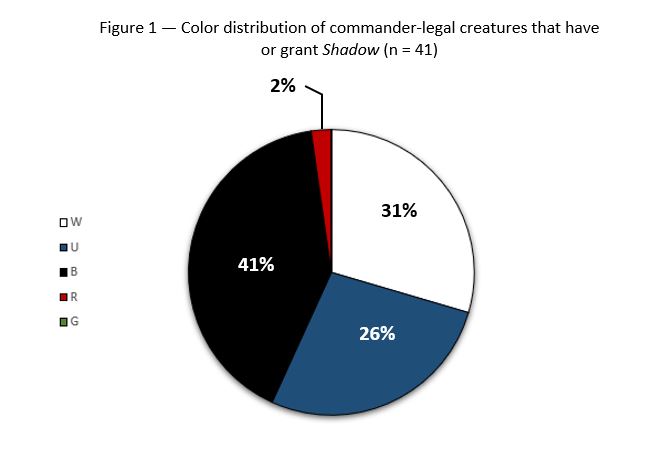
This makes a great deal of sense from a flavor standpoint, as the majority of cards with Shadow belong to one of the three color-specific communities. The only exception is Soltari GuerrillasSoltari Guerrillas, which is, frankly, just awesome to see straight evasion in Boros!
A final advantage is the financial cost of Shadow cards: the mean cost for any card with Shadow is $0.64, and the median is $0.25. Compare that with our last look at Horsemanship, where the mean was $20.44 and the median was $9.46! Other than Nether TraitorNether Traitor, most cards will set you back just a gumball.
The Upside Down(sides)
Creatures with Shadow not being able to block anyone outside of the interstitial void is perfect from a flavor standpoint, but I can actually say that I have a lost a game because of it. Having an untapped Looter il-KorLooter il-Kor facing my fiance's Nezahal, Primal TideNezahal, Primal Tide did about as much as you'd expect an ethereal thief with knit gloves would against a plesiosaur. While we might envision our evasion equates with aggression (and therefore little need for blockers), not even having the option to block can — and will — lose games.
Now pair this with the general stats (power and toughness) and the mana we need to pay for a creature with Shadow:
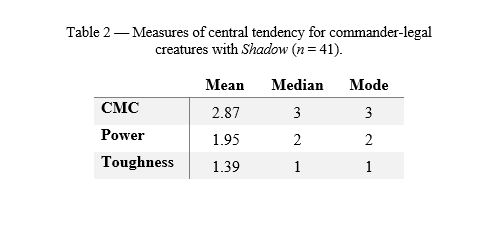 Generally speaking, we are paying 3 mana for a 2/1 body that can't block the vast majority of creatures. While the toughness doesn't seem like it would matter all that much due not blocking, most creatures with Shadow are within pinging range; a simple Prodigal SorcererProdigal Sorcerer, Goblin SharpshooterGoblin Sharpshooter, or even a Goblin ChainwhirlerGoblin Chainwhirler will have a field day with our umbral friends.
Generally speaking, we are paying 3 mana for a 2/1 body that can't block the vast majority of creatures. While the toughness doesn't seem like it would matter all that much due not blocking, most creatures with Shadow are within pinging range; a simple Prodigal SorcererProdigal Sorcerer, Goblin SharpshooterGoblin Sharpshooter, or even a Goblin ChainwhirlerGoblin Chainwhirler will have a field day with our umbral friends.
Shadow is the very definition of a double-edged sword: the very advantages that make its evasive potential so potent in EDH are what make it disadvantageous as a form of protection against bigger and badder threats. Unlike their parasitic counterparts, at least creatures with Horsemanship, flying, or Flanking always have versatility in blocking potential. Outside of a mirror-match, Shadow results in highly un-interactive combat steps where both players can swing with Reckless AbandonReckless Abandon at each other without any fear of blockers — it's part of Mark Rosewater's reasoning behind why it's so problematic:
A Different Shade Of...
Okay, so before we try and build a deck despite all the drawbacks, I'd like to mention where Shadow (ironically) 'shines brightest.' Unlike our previous deck lists where we're incentivized to lean into the keyword as a theme, I think Shadow is fantastic in smaller doses — too much spice can ruin the soup. Decks that can capitalize on Shadow's evasive potential while also mitigating crack-back are in a position to utilize the keyword best.
- Marisi, Breaker of the CoilMarisi, Breaker of the Coil is able to use the evasive nature of the Soltari for his combat damage trigger, which mitigates against their defensive downside as the potential threat is now Goaded to swing elsewhere.
- Marchesa, the Black RoseMarchesa, the Black Rose is able to use the Thalakos to fantastic effects, such as Thalakos SeerThalakos Seer, to repeatedly draw cards, or Thalakos DeceiverThalakos Deceiver to repeatedly steal opponents' creatures, permanently.
- Yuriko, the Tiger's ShadowYuriko, the Tiger's Shadow, aside from literally having Shadow in her name, can also benefit from the Thalakos as well as the Dauthi, either facilitating Ninjutsu capabilities or just straight-up making them Ninjas through Arcane AdaptationArcane Adaptation and ConspiracyConspiracy effects. I mean, who doesn't want Ninjas that strike from interplanar voids? Yuriko, the Tiger's ShadowYuriko, the Tiger's Shadow decks don't care about blockers; they're rewarded for outright aggression and often win before anyone has a chance to set up bigger threats.
Whether it's Marisi, Breaker of the CoilMarisi, Breaker of the Coil's Goading, Marchesa, the Black RoseMarchesa, the Black Rose's ability to recur and steal, or Yuriko, the Tiger's ShadowYuriko, the Tiger's Shadow's brutal aggression and pace, these commanders show how Shadow is likely best used sparingly and rather than a build-around mechanic.
Embrace the Shadows
So the keyword might not be best to build-around, but where's the fun in that? After thinking long and hard on what a deck built around Shadow would look like without just folding to crack-back, I landed on none other than Queen MarchesaQueen Marchesa, First of her Name, long may she reign:
I believe our regal renegade who helped to instigate regicide checks all the boxes:
- She's in 2 of the 3 major colors for Shadow,
- She introduces a form of card advantage that rewards evasion, and
- She disincentivizes opponents from attacking into us thanks to having deathtouch and generating more creatures with deathtouch
Yes, we'll be saying goodbye to our Thalakos friends (they were neutral anyways), and focus on the Soltari and Dauthi. Between the two factions, we get more than 20 creatures with Shadow, which is pretty good.
Our shadowy friends will help us steal back the Monarch if we ever get usurped. We'll use Grenzo, Havoc RaiserGrenzo, Havoc Raiser to help our evasive forces point opponents' creatures elsewhere, or just straight pillage cards from their libraries. The Monarch mechanic should help to give us card advantage, while Mangara, the DiplomatMangara, the Diplomat is perfect from a flavor standpoint and nets us additional cards if opponents are coming after our crown.
Thanks to Shadow being a fairly cheap ($) mechanic, we can splurge a little more on the other cards in our deck. Let's still try and aim for spending no more than $20 on a single card, though.
Dauthi Dealings
Dauthi EmbraceDauthi Embrace is probably one of the better Shadow cards out there, coming down as an affordable enchantment and granting any creature Shadow for merely BB. Dauthi TrapperDauthi Trapper similarly grants a creature Shadow for a mere tap, while Spirit en-DalSpirit en-Dal can repeatedly do the same if we keep it in our hand. Phyrexian SplicerPhyrexian Splicer is a neat old card that temporarily strips an assorted keyword off of one creature and gifts it to another. Yes, it would be much cooler if it hit more keywords and/or the shift was permanent, but, alas, in a set where planes collide, we take what we can get.
In fact, I don't think it's as bad as you think; just think how much the popular Kaalia of the VastKaalia of the Vast depends on flying, both for her to get through and the 99. But also think of just how popular Dragons are, or the recent increase in keyword soup decks thanks to Ikoria: Lair of Behemoths and Kathril, Aspect WarperKathril, Aspect Warper that are being ladled on vEDH nights and kitchen tables alike.
Stripping keywords from an enemy creature may just be worth 2 mana, but the fact of the matter is that this card is (counter-intuitively) good because of its least-effective keyword: Shadow. Being able to move Shadow from a creature we control to another means we have the potential to block incoming threats.
In fact, what's deceptively good about all of these cards is that they grant any creature Shadow. Manipulating Shadow means that we get to temporarily leave our Temporal IsolationTemporal Isolation and step out of the shadow-realm to block non-Shadow creatures, just like Will Beyers peeking through the wall.
Alternatively, granting a creature that's attacking us Shadow allows us to bring them into the Upside Down and parasitically block them. We can also grant an opponent's potential blockers Shadow, making it so that they can't block any of our other opponents' creatures. Finally, we can give an opponent's attacking creature Shadow with any of the above cards when they swing at an opponent, effectively making them unblockable. Pair these effects with Duelists' HeritageDuelists' Heritage, and we can really start facilitating damage between opponents. We can orchestrate various political maneuvers from — quite literally — the shadows.
A Crown's Greatest Weapon is the Gavel
To protect our monarchy and defend against the downsides of Shadow, we'll lean into Queen Marchesa'sQueen Marchesa's popular Aikido theme. Asides from straight removal, we'll utilize a myriad of instant-speed effects that punish our opponents for looking our way.
ComeuppanceComeuppance is a classic form of damage prevention and reflection. Eye for an EyeEye for an Eye is just the kind of Hammurabbian justice we promote in our monarchy, reflecting damage that our Shadow creatures can't block. Harsh JusticeHarsh Justice is our motto in matters of jurisprudence, and happens to affect all creatures attacking us. Plus, a sorcery errata'd to an instant is just too good to pass up on (oh Portal: Three Kingdoms, how I love thee). Rakdos CharmRakdos Charm and Batwing BrumeBatwing Brume handle go-wide strategies, while BacklashBacklash and DeliriumDelirium can tackle big, stompy creatures.
SunforgerSunforger acts as our thematic gavel, handing down sentences, protecting our monarchy, and ensuring dissidents are quashed. SpellbinderSpellbinder is a card I've always wanted to try, and given our hefty count of instants paired with evasive creatures, I think it's worth a shot. Quietus SpikeQuietus Spike similarly aids our shadowy friends in hastening the game.
Flawless ManeuverFlawless Maneuver and Boros CharmBoros Charm help protect our shadowy assassins. Alesha, Who Smiles at DeathAlesha, Who Smiles at Death can bring back every one of our shady friends except for Dauthi MarauderDauthi Marauder and Soltari GuerrillasSoltari Guerrillas. Thanks to the low CMC of creatures with Shadow, Sun TitanSun Titan can bring back every single one outside of Dauthi MindripperDauthi Mindripper and Soltari GuerrillasSoltari Guerrillas. After all, what are shadows without the sun?
Put it all together, and here's a list that ensures our monarchy is here to stay:
Queen Marchesa: Shadowy Reign
View on ArchidektCommander (1)
- 1 Queen MarchesaQueen Marchesa
Creatures (26)
- 1 Alesha, Who Smiles at DeathAlesha, Who Smiles at Death
- 1 Dauthi CutthroatDauthi Cutthroat
- 1 Dauthi GhoulDauthi Ghoul
- 1 Dauthi HorrorDauthi Horror
- 1 Dauthi JackalDauthi Jackal
- 1 Dauthi MarauderDauthi Marauder
- 1 Dauthi MercenaryDauthi Mercenary
- 1 Dauthi MindripperDauthi Mindripper
- 1 Dauthi SlayerDauthi Slayer
- 1 Dauthi TrapperDauthi Trapper
- 1 Dauthi WarlordDauthi Warlord
- 1 Grenzo, Havoc RaiserGrenzo, Havoc Raiser
- 1 Mangara, the DiplomatMangara, the Diplomat
- 1 Nether TraitorNether Traitor
- 1 Soltari ChampionSoltari Champion
- 1 Soltari CrusaderSoltari Crusader
- 1 Soltari EmissarySoltari Emissary
- 1 Soltari Foot SoldierSoltari Foot Soldier
- 1 Soltari GuerrillasSoltari Guerrillas
- 1 Soltari MonkSoltari Monk
- 1 Soltari PriestSoltari Priest
- 1 Soltari TrooperSoltari Trooper
- 1 Soltari VisionarySoltari Visionary
- 1 Spirit en-dalSpirit en-dal
- 1 Sun TitanSun Titan
- 1 Zealot il-VecZealot il-Vec
Instants (18)
- 1 Anguished UnmakingAnguished Unmaking
- 1 BacklashBacklash
- 1 Batwing BrumeBatwing Brume
- 1 Boros CharmBoros Charm
- 1 ComeuppanceComeuppance
- 1 Crush ContrabandCrush Contraband
- 1 Deflecting SwatDeflecting Swat
- 1 DeliriumDelirium
- 1 DesparkDespark
- 1 Eye for an EyeEye for an Eye
- 1 Flawless ManeuverFlawless Maneuver
- 1 Generous GiftGenerous Gift
- 1 Harsh JusticeHarsh Justice
- 1 Kaya's GuileKaya's Guile
- 1 Path to ExilePath to Exile
- 1 Rakdos CharmRakdos Charm
- 1 Settle the WreckageSettle the Wreckage
- 1 Swords to PlowsharesSwords to Plowshares
Sorceries (3)
- 1 Blasphemous ActBlasphemous Act
- 1 Council's JudgmentCouncil's Judgment
- 1 Open the ArmoryOpen the Armory
Artifacts (14)
- 1 Arcane SignetArcane Signet
- 1 Boros SignetBoros Signet
- 1 Chromatic LanternChromatic Lantern
- 1 Orzhov SignetOrzhov Signet
- 1 Phyrexian SplicerPhyrexian Splicer
- 1 Quietus SpikeQuietus Spike
- 1 Rakdos SignetRakdos Signet
- 1 Sol RingSol Ring
- 1 SpellbinderSpellbinder
- 1 SunforgerSunforger
- 1 Talisman of ConvictionTalisman of Conviction
- 1 Talisman of HierarchyTalisman of Hierarchy
- 1 Talisman of IndulgenceTalisman of Indulgence
- 1 Thaumatic CompassThaumatic Compass
Enchantment (2)
- 1 Dauthi EmbraceDauthi Embrace
- 1 Duelist's HeritageDuelist's Heritage
Lands (36)
- 1 Battlefield ForgeBattlefield Forge
- 1 Blood CryptBlood Crypt
- 1 Bojuka BogBojuka Bog
- 1 Caves of KoilosCaves of Koilos
- 1 Clifftop RetreatClifftop Retreat
- 1 Command TowerCommand Tower
- 1 Dragonskull SummitDragonskull Summit
- 1 Fabled PassageFabled Passage
- 1 Fetid HeathFetid Heath
- 1 Godless ShrineGodless Shrine
- 1 Graven CairnsGraven Cairns
- 1 Isolated ChapelIsolated Chapel
- 1 Luxury SuiteLuxury Suite
- 1 Maze of ShadowsMaze of Shadows
- 1 Mistveil PlainsMistveil Plains
- 3 MountainMountain
- 6 PlainsPlains
- 1 Rugged PrairieRugged Prairie
- 1 Sacred FoundrySacred Foundry
- 1 Savai TriomeSavai Triome
- 1 Silent ClearingSilent Clearing
- 1 Sulfurous SpringsSulfurous Springs
- 1 Sunbaked CanyonSunbaked Canyon
- 5 SwampSwamp
- 1 Tainted FieldTainted Field
Pax Paliana
So how'd we do? Does ruling a monarchy from the shadows give you that playstyle that you like while maintaining a Lagasse pinch of something extra?
There are many potential upgrades if budget allows (e.g. No MercyNo Mercy). If we really wanted to be brutal but maintain our budget restrictions, we might splash a LarcenyLarceny, which turns our creatures with Shadow into Specters, stripping our opponents of their resources. Or, you know, an Undercity PlagueUndercity Plague, because the world needs more Cipher.
How does Shadow fare in your meta? Are you hoping for a return of Shadow in some sort of wacky keyword-salad set like Modern Horizons?
Sound off in the comments below, and, as always, embrace the shadows.
Trent Trombley
Trent has been playing Magic since the early 2000s, when instead of exercising in a summer sports camp, he was trying to resolve a Krosan Skyscraper on the sidewalk (it always ate a removal). He saved up his allowance to buy an Akroma Angel of Wrath on eBay, only to find out it was a fraudulent post, forever dashing his hopes of ever getting a big creature to stick. He’s since “grown up” and, when he’s not working on his dissertation in Archaeology, spends too much time thinking how to put Cipher in every one of his decks and digging for obscure cards (see photo).
Your opinions are welcome. We love hearing what you think about Magic! We ask that you are always respectful when commenting. Please keep in mind how your comments could be interpreted by others. Personal attacks on our writers or other commenters will not be tolerated. Your comments may be removed if your language could be interpreted as aggressive or disrespectful. You may also be banned from writing further comments.

